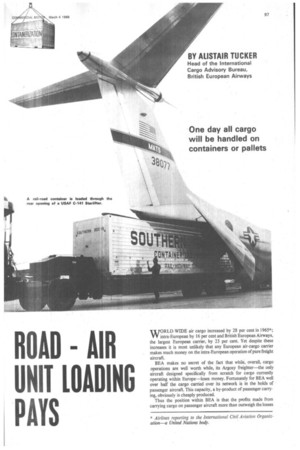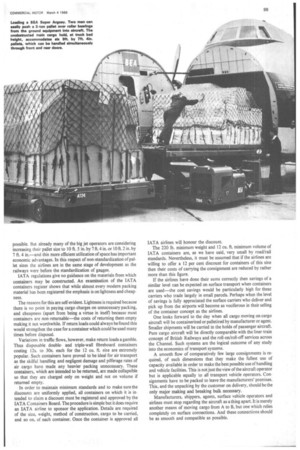ROAD AIR UNIT LOADING PAYS
Page 99

Page 100

Page 101

If you've noticed an error in this article please click here to report it so we can fix it.
One day all cargo will be handled on containers or pallets BY ALISTAIR TUCKER
Head of the International Cargo Advisory Bureaus British European Airways WORLD-WIDE air cargo increased by 28 per cent in 19654'; intra-European by 16 per cent and British European Airways, the largest European carrier, by 23 per cent. Yet despite these increases it is most unlikely that any European air-cargo carrier makes much money on the intra-European operation of pure freight aircraft.
BEA makes no secret of the fact that while, overall, cargo operations are well worth while, its Argosy freighter—the only aircraft designed specifically from scratch for cargo currently operating within Europe—loses money. Fortunately for BEA well over half the cargo carried over its network is in the holds of passenger aircraft. This capacity, a by-product of passenger carrying, obviously is cheaply produced. Thus the position within BEA is that the profits made from carrying cargo on passenger aircraft more than outweigh the losses on pure freighters. BEA is unhappy about this cross-subsidization. It provides no basis on which profitable expansion can take place— for when cargo capacity on passenger aircraft is fully utilized then any expansion must be in the pure freighter fleet, the loss-making side of the business.
BEA has said it intends to correct this unprofitable position on freighters within the next year by (a) increasing vehicle (in this case aircraft) productivity; (b) reducing ground handling costs: (c) raising the size of .average loads.
These three problems are not peculiar to air transport—they are areas of casts on which all transport providers must concentrate if they want an economic, viable operation. And they are areas in which containerization and palletization can make for startling reductions.
Any vehicle is an expensive piece of capital equipment to leave lying around—it must be worked as hard as possible. So it is kept moving, and in the dock, depot, or on the ground at the airport as little as possible. This in turn requires facilities for the fastest possible loading and unloading.
All modern cargo aircraft are fully palletized, the pallets running on to the aircraft from surface vehicles equipped with roller bearings and within the aircraft on similar rollers. Pallets are pre-loaded in the warehouse, towed to the aircraft side, raised to the level of the aircraft sill then rolled aboard. Two men can easily move a fullyloaded pallet weighing perhaps 31,. tons.
This sort of operation makes for extremely fast turn-rounds--thebiggest jet freighters with a payload of more than 40 tons need be on the ground for only one hour. Converted passenger aircraft, like the Douglas DC7, would require considerably longer to hand load only 15 tons. A quick glance at the timetable shows the difference. BEA operates both 7-ton Viscounts and 12-ton Argosies between London and Paris. The Viscount requires a 90 min. turnround—the Argosy only 45 min.
Fig. 1 shows the effect on productivity, expressed in capacity ton/miles per day, of the lengthening turn-round times of a 12-ton cargo aircraft over 200-mile stages and averaging 200 m.p.h. The aircraft is available for 20 hours on a typical day—the other four hours being required for maintenance. In this example, a reduction in turn-round time from two hours to 30 min. is effected by the introduction of palletization, and a sophisticated ground-handling system means that vehicle productivity is doubled.
The rigid pallets used on the Argosy are international size() ft. by 7 ft. 4 in.—and can be loaded up to 6 ft. high with a maximum permissible weight of 8,000 lb. These pallets are interchangeable between most modern cargo aircraft and are equally suitable for roller-equipped road transport. They can be loaded in the manufacturers' premises, transported to the airport and loaded straight on to the aircraft. In this way handling and damage is cut to an absolute minimum.
For some time J. Lyons and Co. have used this method of transporting cakes from their bakery in London to their shops in the Channel Islands. It is certain that as air cargo progresses such road/ air interchangeability will increase and manufacturers offering large regular consignments to the air carriers will be encouraged to load aircraft pallets within their own premises and have them delivered on the same pallet to the ultimate destination.
Such a system would reduce ground handling for both road haulier and airline at airports to a minimum and help to reduce one of the largest areas of costs in any transport system. It should be possible to load or unload a 10-ton lorry within 15 mm.
One of the most advanced proposals, designed with a view to road/rail/air interchangeability and co-operation, is the Lockheed Super Starlifter. This aircraft can take the 8 ft. wide by 8 ft. tall by 40 ft. long containers that are widely used by American railways and road hauliers. Lockheeds have published, in Fig. 2, a comparison of operating costs of the Super Starlifter using different loading systems. By raising the unit size of the average consignment from 200 lb. for hand-loaded systems to 8,000 lb. for containers on pallets, operating costs are approximately halved.
Within Europe, however, such aircraft and containers are very much of the future as there are few, if any, shippers or agents who can regularly, at this time, fill a container of these dimensions. Recognizing this, but equally recognizing that ground-handling costs must be reduced to make operations profitable—especially short-haul where handling costs are a high proportion of total costs —airlines belonging to the International Air Transport Association (this includes BEA and BOAC) have introduced a container programme which is intended to raise the average size of consignments by offering incentives to shippers to consolidate small shipments into larger consignments.
IATA regulations state that. within Europe and between the Americas and Europe, a 12 per cent discount on the air cargo rate will be given if goods are shipped in an IATA approved container. Other areas of the world have slightly different regulations.
By road and rail standards air-cargo containers are pretty small beer. For IATA approval, containers on international routes must not be smaller than 12 Cu. ft.; when full weigh not less than 220 lb.; if weighing more than 500 lb. have a built-in pallet or false base to permit fork-lift capability; and must have a top loading capacity or not less than 50 lb./ft.2
While there is no specific IATA ruling—although they are working in this direction—airlines encourage containers to be modules of the aircraft pallet. This simplifies loading and makes for the more economical use of pallet space, so permitting an increase in average loads. The problem as a whole, however, is not simplified by the non-standardization of aircraft pallets. For a while it seemed as though the 9 ft. by 7 ft. 4 in. size would become standard and this is why the fleet of five BEA Argosies are so equipped in order to provide full interchangeability of pallets, aircraft to aircraft.
BEA intra-European Argosy services are thus feeders to the European gateways of the long-haul cargo carriers providing them with many more freighter outlets than otherwise would have been possible. But already many of the big jet operators are considering increasing their pallet size to 10 ft. 5 in. by 7 ft. 4 in. or 10 ft. 2 in. by 7 ft. 4 in.—and this more efficient utilization of space has important economic advantages. In this respect of non-standardization of pallet sizes the airlines are in the same stage of development as the railways were before the standardization of gauges.
IATA regulations give no guidance on the materials from which containers may be constructed. An examination of the IATA containers register shows that while almost every modern packing material has been registered the emphasis is on lightness and cheapness.
The reasons for this are self-evident. Lightness is required because there is no point in paying cargo charges on unnecessary packing, and cheapness (apart from being a virtue in itself) because most containers are non-returnable—the costs of returning them empty making it not worthwhile. If return loads could always be found this would strengthen the case for a container which could be used many times before disposal.
Variations in traffic flows, however, make return loads a gamble. Thus disposable doubleand triple-wall fibreboard containers costing 12s. to 30s. each for the 12 Cu. ft. size are extremely popular. Such containers have proved to be ideal for air transport as the skilful handling and negligent damage and pilferage rates of air cargo have made any heavier packing unnecessary. These containers, which are intended to be returned, are made collapsible so that they are charged only on weight and not on volume if returned empty.
In order to maintain minimum standards and to make sure the discounts are uniformly applied, all containers on which it is intended to claim a discount must be registered and approved by the IATA Containers Board. The procedure is simple but it does require an IATA airline to sponsor the application. Details are required of the size, weight, method of construction, cargo to be carried, and so on, of each container. Once the container is approved all IATA airlines will honour the discount.
The 220 lb. minimum weight and 12 Cu. ft. minimum volume of IATA containers are, as we have said, very small by road/rail standards. Nevertheless, it must be assumed that if the airlines are willing to offer a 12 per cent discount for containers of this size then their costs of carrying the consignment are reduced by rather more than this figure.
If the airlines have done their sums correctly then savings of a similar level can be expected on surface transport when containers are used—the cost savings would be particularly high for these carriers who trade largely in small parcels. Perhaps when the level of savings is fully appreciated the surface carriers who deliver and pick up from the airports will become as vociferous in their selling of the container concept as the airlines.
One looks forward to the day when all cargo moving on cargo aircraft will be containerized or palletized by manufacturer or agent. Smaller shipments will be carried in the holds of passenger aircraft. Pure cargo aircraft will be directly comparable with the liner-train concept of British Railways and the roll-on/roll-off services across the Channel. Such systems are the logical outcome of any study into the economics of transport systems.
A smooth flow of comparatively few large consignments is required, of such dimensions that they make the fullest use of capacity available in order to make the best possible use of handling and vehicle facilities. This is not just the view of the aircraft operator but is applicable equally to all transport vehicle operators. Consignments have to be packed to leave the manufacturers' premises. This, and the unpacking by the customer on delivery, should be the only major making and breaking bulk necessary.
Manufacturers, shippers, agents, surface vehicle operators and airlines must stop regarding the aircraft as a thing apart. It is merely another means of moving cargo from A to B, but one which relies completely on surface connections. And these connections should be as smooth and compatible as possible.
























































































































































